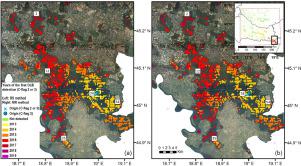Agricultural and Forest Meteorology ( IF 6.2 ) Pub Date : 2021-05-03 , DOI: 10.1016/j.agrformet.2021.108436 Anikó Kern , Hrvoje Marjanović , György Csóka , Norbert Móricz , Milan Pernek , Anikó Hirka , Dinka Matošević , Márton Paulin , Goran Kovač

|
The oak lace bug (Corythucha arcuata, Say 1832) is a new invasive sap-sucking species in the European oak forests that was first recorded in Central Europe in 2013. It invaded the region from Southeastern Europe, spreads rapidly, and shows no signs of receding after establishment. In this study, focusing on the oak forests in the transboundary area of Hungary and Croatia, we applied two novel methods for detecting and assessing the impact of the oak lace bug (OLB) during the period 2000–2019 based on MODIS NDVI measured at 250 m spatial and 8-day temporal resolution. The first detection method is based purely on NDVI and has the potential to be used in near real-time detection. The second one, based on the residual Z-score of the NDVI models using daily meteorological and soil water content data as independent variables, aims at improved OLB damage assessment by decoupling the effects of the OLB from those caused by the environmental drivers. The presented detection methods had 61.1% to 93.8% agreement with the in situ data, with a better agreement in forests with high oak share. The overall share of the false-positive OLB detections for the strictest method of model residuals was 1.8%. The results confirmed a strong and year-to-year persistent NDVI decrease (down to -14.5% in pure oak forests) during the late summer which can be attributed to the OLB. The origin of the infestation in the study area was identified to be near a resting station on the major highway from Southeastern to Western Europe, corroborating the assumptions that the OLB spread was primarily facilitated by the transport system. The detected speed of the OLB radial spread in the first 3 years of infestation was under 6 km y-1, but since then it increased to above 50 km y-1.
中文翻译:

使用MODIS和气象数据检测橡树林中的橡树花边臭虫侵扰
橡树虫(Corythucha arcuata,说1832年)是欧洲橡树林中的一种新的入侵性树液吸收物种,于2013年在中欧首次发现。它从东南欧入侵该地区,迅速蔓延,没有迹象表明建立后退去。在这项研究中,我们针对匈牙利和克罗地亚跨界地区的橡树林,应用了两种新颖的方法来检测和评估2000年至2019年期间橡树虫(OLB)的影响,该方法基于250的MODIS NDVI进行了测量。 m空间和8天时间分辨率。第一种检测方法完全基于NDVI,并且有可能用于近实时检测。第二个,基于剩余的Z得分使用每日气象和土壤含水量数据作为自变量的NDVI模型,旨在通过将OLB的影响与环境驱动因素所产生的影响分离开来,以改善OLB的损害评估。提出的检测方法与原位一致率为61.1%〜93.8%。数据,在橡树占有率高的森林中达成更好的协议。对于模型残差的最严格方法,假阳性OLB检测的总份额为1.8%。结果证实,夏末期间NDVI呈强劲且逐年持续下降的趋势(在纯橡树林中下降至-14.5%),这可以归因于OLB。研究区域的疫情起源被确定为位于东南欧至西欧主要公路上的一个静息站附近,这证实了以下假设:运输系统主要促进了OLB传播。在侵害的前3年中,检测到的OLB径向扩散速度低于6 km y -1,但自此之后上升到50 km y -1以上。



























 京公网安备 11010802027423号
京公网安备 11010802027423号